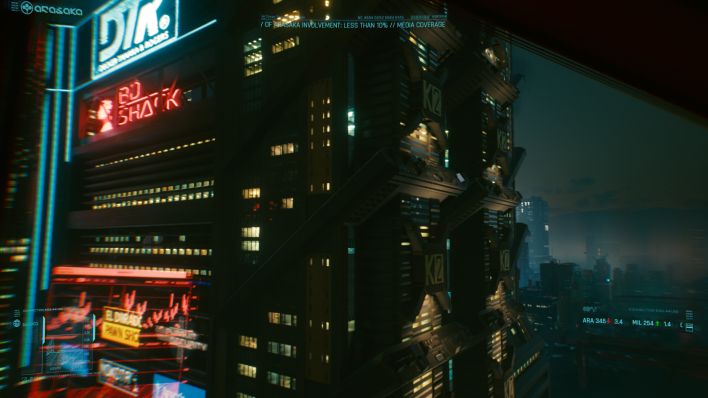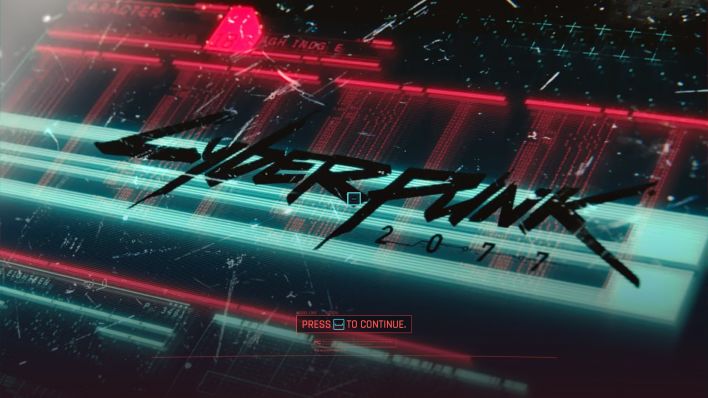Cyberpunk 2077 Review: Gameplay, Performance & Optimization
Cyberpunk 2077: Game Engine Tech And Graphics Performance
Cyberpunk 2077 Graphics
Cyberpunk ticks all the graphics features boxes a triple-A, high-profile title needs to check in 2020. Cyberpunk 2077's system requirements make some recommendations about what it takes to see all that eye candy. The game makes extensive use of DirectX Ray Tracing (DXR), although for the moment it's only supported on NVIDIA hardware, even though AMD's latest GPUs support the technology. CDPR says Cyberpunk will get a patch sometime next year to enable DXR on Radeon RX 6800 and 6900 series GPUs. The same is true for next-gen console versions, and since the Xbox Series X and PlayStation 5 use AMD's hardware, our guess is that all of that will drop around the same time.DXR finds its way into Cyberpunk 2077 in five different ways. First, reflective surfaces like water and glass all have raytraced reflections. Diffused illumination means that all of the neon signs in Night City accurately light up their surroundings with ray tracing. All of the shadows in Cyberpunk can be completely raytraced as well. The global illumination model — that means the sun, street lights, indoor lighting and so on — all uses DirectX Ray Tracing to cast light on the scenery, too. All of those methods result in a fifth detail that's not really a separate implementation: raytraced ambient occlusion. This is a form of self-shadowing, when an item, like a piece of cloth, has folds and waves resulting in casting shadows on top of itself. Let's take a look at some of those effects in action at different levels of detail.
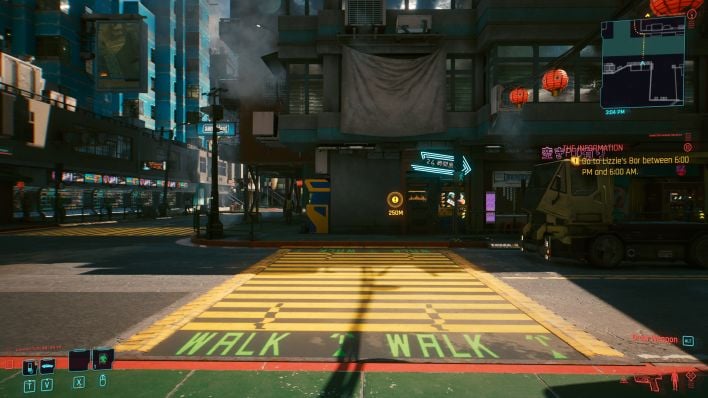

In the images above, we can see that the shadows look very different between Ultra without ray tracing and Ultra Ray Tracing. The buildings are relatively tall, which means the shadows should be pretty soft by the time they hit the ground. That's much more apparent with ray tracing than without. Ray traced ambient occlusion is very obvious in the way this building's balcony causes it to cast a shadow on the wall, too. On the left, the windows reflect the side of the building across the street, even though it's not rendered to the screen. Lastly, the neon "24-hour" sign across the street from our location lights up the area around it much more realistically. Let's take a look at another example...
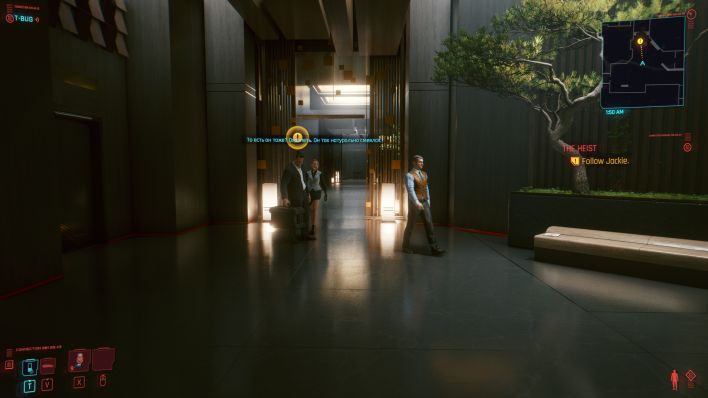
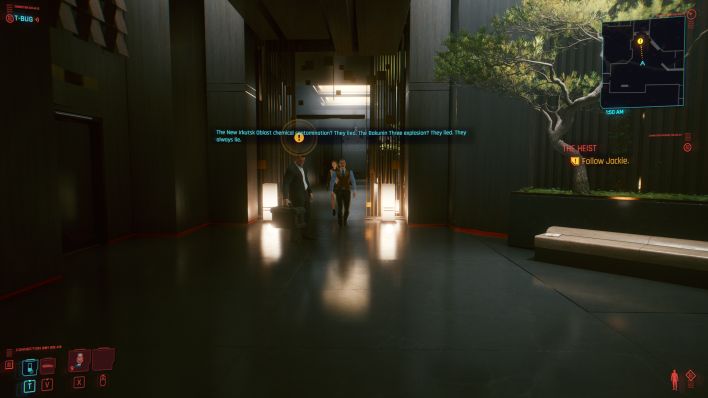
Indoors, bright lights and shiny objects interact in a believable enough way without any ray tracing, but the effect is much more realistic once DXR factors in. There are a lot of subtle differences in the way the light reflects off of those two lighted accents in the hallway. Even the hue of the light they put off at the top -- away from the light bulb -- is different than without DXR. On the right, the bench reflection in the floor shows the wooden base, but without RT for some reason it only reflects the cushion's beige color for the full height of the reflection.
The downside, as it always is with DXR, is that all of this ray tracing can have a pretty hefty impact on performance. On our GeForce RTX 3070, the game is playable without any upscaling, but it's not particularly smooth at 1440p. To combat that, Cyberpunk 2077 also makes extensive use of NVIDIA's updated Deep Learning Super Sampling (DLSS 2.0). DLSS can upscale lower-resolution images with the help of AI to put back missing details. It does a pretty good job as long as you can stick to Quality or Balanced DLSS, but details start to disappear for good below that. Stay tuned, though, because we'll see exactly how the game performs with and without DLSS shortly.
Cyberpunk 2077 Graphics Performance
To test Cyberpunk 2077, we used the aforementioned hack to speed up our Ryzen 7 3700X and Ryzen 9 3900X. We'll look very briefly at CPU scaling, but as long as the CPU churns out frames fast enough to keep the GPU busy, we're much more interested in graphics scaling across multiple DXR-capable GPUs from NVIDIA. While the Radeon RX 6800 and 6900 family supports DXR, Cyberpunk 2077 only supports Turing and Ampere-based cards at this time. When we test non-raytraced performance, we'll throw in an AMD Radeon RX 5700 XT as well.We had our sights on generating frame times for some inside-the-second analysis, but the fact is the game just didn't need it. Cyberpunk plummets to unplayable frame rates before individual frame times spike or stutter too much. For example, without any DLSS and at 1080p, our GeForce RTX 2080 Super and Ryzen 7 3700X generated the following.
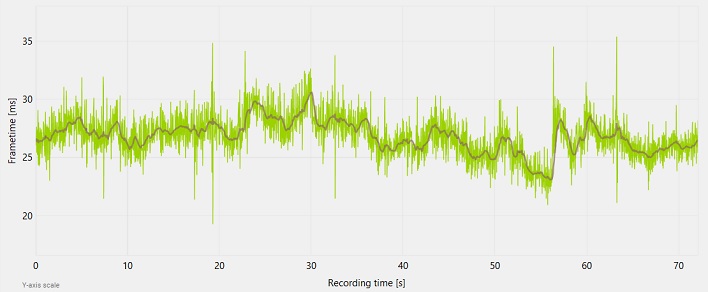
That's a 38 fps average and only a single frame took longer than 35 milliseconds to render. Once DLSS comes into play, the charts get even flatter. Here's a 47-fps average for the same setup with Quality DLSS at 1080p:
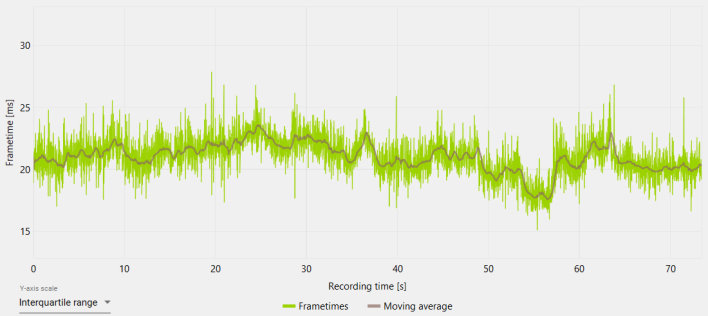
Rather than bore you with these charts with no outliers, we figure this proves the point that Cyberpunk runs smoothly. Without further ado, let's take a look at the actual performance.
|

There are some decent performance gains to be realized with the Ryzen 7 3700X, at the very least. The caveat here is that the graphics card can't be the limiting factor. We can see that with the Ryzen 7 3700X there's around an 11% gain. By contrast, the Ryzen 9 3900X gained almost nothing. We tested with Ultra Ray Tracing at 1440p, but with Performance DLSS 2.0. This results in a native 1280 x 720 image that's upscaled by a factor of two vertically and horizontally.
It's possible that we might have, again, hit a limit on our GeForce RTX 2080 SUPER, but 720p images are fairly low-res. DLSS 2.0 is nice, but it's not magic, and upscaling anything lower quality than that gets pretty blocky. The next step down is Ultra Performance, which is just 1/9 of the native display resolution's pixels, which works out to 480p. That's pretty ugly, so we don't really recommend it if it can be avoided. We'd rather turn off ray tracing first.
|

We start off our run with no DXR enabled. That allows us to add a Radeon RX 5700 XT to our pile of GeForces to see how the title runs on the red team. At the bottom, the GeForce RTX 2060 is CDPR's Medium Ray Tracing preset target, which includes the Ultra preset's raster settings along with some ray tracing effects. Without any DXR or DLSS, the game is only really playable on High, and less so on Ultra at 1080p. The next step up the ladder includes the Radeon RX 5700 XT and the GeForce RTX 2080 SUPER. The Radeon outruns Turing, but Turing has those extra effects up its sleeve. This is as good as it gets for Navi. As expected, the Ampere cards dominate this round, eclipsing 70 fps on Ultra and High alike.
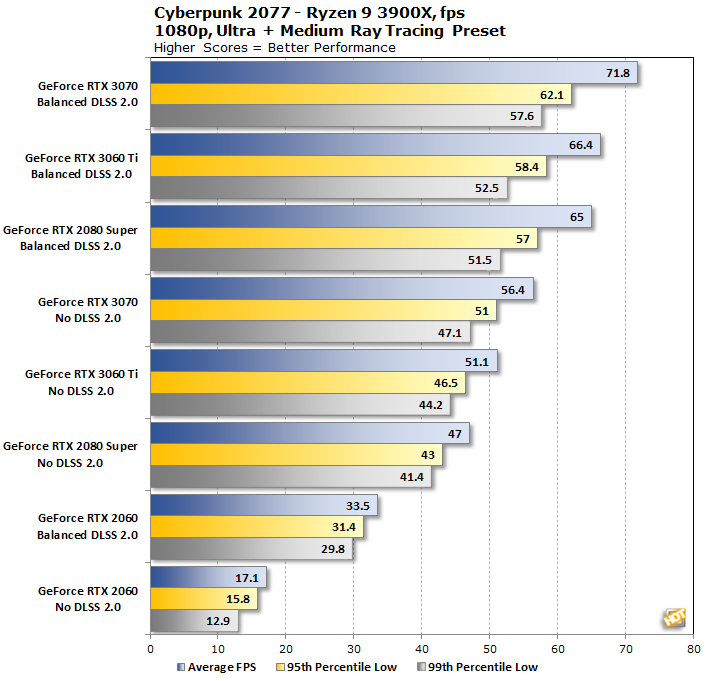
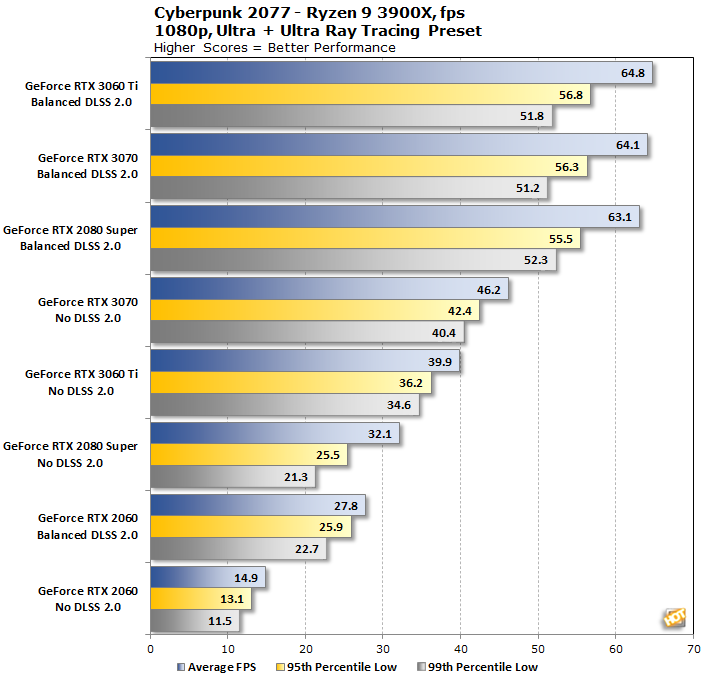
If you'd rather break 60 fps on average or want to turn up the visuals to the maximum, a dash of DLSS is just what the doctor ordered. The bad news is that, once again, we think we've hit a CPU wall. The GeForce RTX 3070 is not appreciably faster than the GeForce RTX 2080 SUPER, and the RTX 3060 Ti wins the Ultra test overall by a very slim margin. Remember that we're running a manual test with randomly-generated pedestrians and vehicles, which effectively means these three cards tied with Balanced DLSS at 1080p. That does not reflect their potential, so all we can do is blame our powerful 12-core CPU for not being powerful enough.
|

Without Ray Tracing, the Radeon returns. However, its performance at 1440p wanes considerably faster than its competition. This time around the GeForce RTX 2080 SUPER is quite a bit faster than the Radeon, which normally performs more or less on par with the weaker GeForce RTX 2070 SUPER. Again, the reset of the cards fall in line exactly as expected, with the GeForce RTX 3070 on top and the GeForce RTX 2060 at the end. The poor 2060 plummeted pretty hard from 1080p, no doubt a casualty of its narrower 192-bit memory bus.
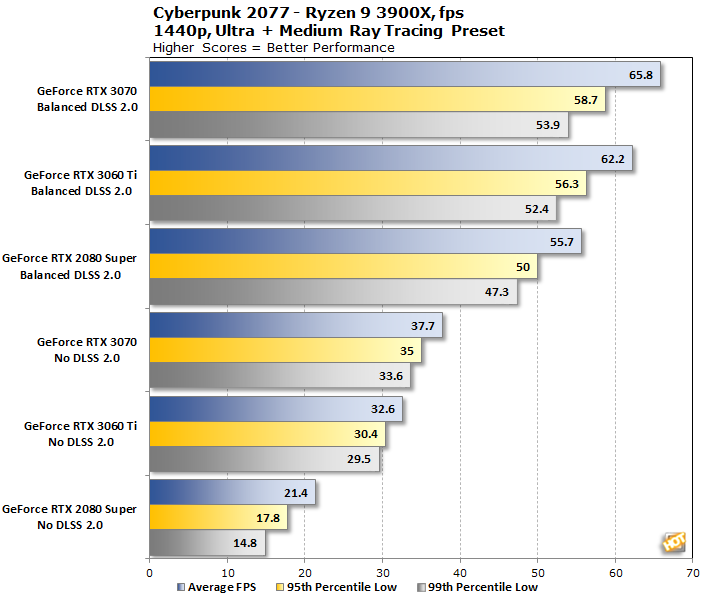

After the beating the GeForce RTX 2060 took at 1080p, we felt no urgency to include it in our 1440p ray tracing tests. Whatever the result would have been, we're positive the non-DLSS test would have been in the single-digits, and it was nearly impossible to move with any accuracy, anyway. Some neat comparisons here are that with Ultra ray tracing, the GeForce RTX 3070 is about as fast with DLSS disabled as the GeForce RTX 2080 SUPER is with Balanced DLSS. With the lighter Medium Ray Tracing run, Balanced DLSS produced pretty smooth results for the cards that remained.
We did not do 4K tests, but to get an idea of how the game would run, refer to 1080p with DLSS disabled. Performance DLSS 2.0 is 1/4 of the total pixels of the native display resolution, so 1080p would be upscaled to 4K with that setting. With that in mind, the GeForce RTX 3070 should provide relatively smooth frame rates at Medium Ray Tracing and 4K with Performance DLSS. The GeForce RTX 3060 Ti would be playable, but not particularly smooth. Ultra Performance DLSS should run smoothly on both, and that upscales from 720p to UHD 2160p. The details might get lost a bit, but it should still look pretty decent. We'd advise a faster GPU (GeForce RTX 3080 or 3090 being the only choices) when playing with DXR at 4K. Even without ray tracing, you still might want some DLSS to make it lighter on the GPU.
Cyberpunk 2077 Conclusions
Cyberpunk 2077 had to live up to impossible expectations thanks to all the hype surrounding the title. In fairness to the people who hold those expectations, CD Projekt itself was responsible for setting them. There's a real chance that even a perfect game would not have met everyone's desires, but that's okay. When we strip away all the hype and examine the game on its own merits, it's a really good game.First and foremost, the story and characters sucked us right in. We were so engrossed in the plot and hooked on the universe that we literally lost hours just playing. We had to see what happened next, and that's the mark of a good story. The voice acting is great across the board, the soundtrack is befitting the environment, and the game world's retro-futuristic aesthetic just works. While the main missions are somewhat linear, that doesn't detract from the experience. We'd like more customization options when we create our V, and we'd really love a camera angle to see more of them, though.
For the most part, combat is satisfying and fun. First-person shooter enthusiasts will have no problem pulling off headshots. Intuitive keyboard controls make sneaking around stealthily simple and exciting. The one recommendation we have is that, unlike many games with console ports, playing with a controller is not advised. Use a keyboard and mouse. The FPS-style action really just begs for a mouse.
Graphically, Cyberpunk 2077 is beautiful. Especially with DirectX Ray Tracing with an NVIDIA GeForce RTX graphics card, the lighting is perfect. Night City just comes alive, especially after dark. The random vehicles and people on the streets are varied and detailed. We just wandered the city for hours, taking in all the sights while getting cursed at by passersby. Right now this is a game to experience with a shiny new Ampere graphics card, once you can get your hands on one, but that tech will come to Radeons soon too. Hopefully around the same time as AMD's upscaler, since DXR does require quite a bit of resources.
In the end the biggest complaint we have about the game is perhaps the most fixable: the bugs. Despite multiple delays running up to its December 10th release, it's still a little glitchy. For example, it's a little jarring when pedestrians and vehicles pull the old switcheroo, appearing out of thin air and disappearing when our back is turned. Performance on AMD processors seems to have gotten lost in the shuffle, too. We're hopeful that CD Projekt Red will be quick to squash those bugs, and since the game has already gotten one hot fix we're confident there will be more. Despite these bugs, or perhaps once they've been vanquished for good, we heartily recommend taking a turn around Night City. Cyberpunk 2077 is great.

